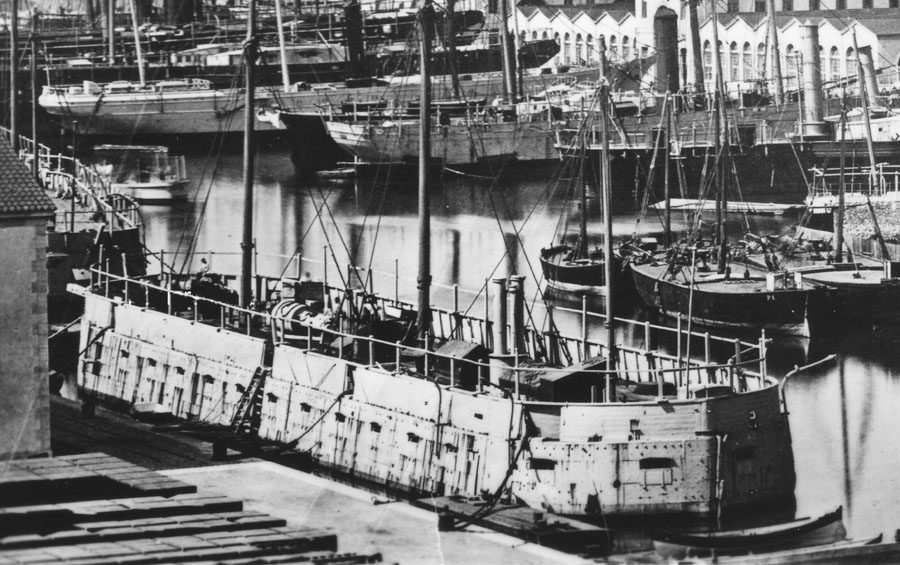Floating Batteries on:
[Wikipedia]
[Google]
[Amazon]


 A floating battery is a kind of armed watercraft, often improvised or experimental, which carries heavy armament but has few other qualities as a warship.
A floating battery is a kind of armed watercraft, often improvised or experimental, which carries heavy armament but has few other qualities as a warship.


 A floating battery is a kind of armed watercraft, often improvised or experimental, which carries heavy armament but has few other qualities as a warship.
A floating battery is a kind of armed watercraft, often improvised or experimental, which carries heavy armament but has few other qualities as a warship.
History
Use of timber rafts loaded with cannon by Danish defenders of Copenhagen against bomb ketches of a combined British-Dutch-Swedish fleet is attested by Nathaniel Uring in 1700. An early appearance was in 1782 at theGreat Siege of Gibraltar
The Great Siege of Gibraltar was an unsuccessful attempt by Spain and France to capture Gibraltar from the British during the War of the American Revolution. It was the largest battle in the war by number of combatants. The American war had end ...
, and its invention and usage is attributed to Spanish Lieutenant General Antonio Barceló.
A purpose-built floating battery was ''Flådebatteri No. 1'', designed by Chief Engineer Henrik Gerner
Henrik Gerner (1742–1787) was a Danish naval officer who specialised in shipbuilding and naval architecture. His interests as an entrepreneurial engineer led to unsinkable gun platforms, horse-driven dredging machines, and desalination equipmen ...
in 1787; it was long, wide and armed with 24 guns, and was used during the 1801 Battle of Copenhagen under the command of Peter Willemoes. The British made limited use of floating batteries during the French Revolutionary and Napoleonic Wars, with the two-vessel and -class floating batteries, and some individual vessels such as .
The most notable floating batteries were built or designed in the 19th century, and are related to the development of the first steam warship and the ironclad warship.
'' Demologos'', the first steam-propelled warship, was a floating battery designed for the protection of New York Harbor
New York Harbor is at the mouth of the Hudson River where it empties into New York Bay near the East River tidal estuary, and then into the Atlantic Ocean on the east coast of the United States. It is one of the largest natural harbors in t ...
in the War of 1812.
In the 1850s, the British and French navies deployed iron-armoured floating batteries as a supplement to the wooden steam battlefleet in the Crimean War. The role of the battery was to assist unarmoured mortar and gunboats bombarding shore fortifications. The French used their batteries in 1855 against the defenses at Kinburn on the Black Sea, where they were effective against Russian shore defences. The British planned to use theirs in the Baltic Sea against Kronstadt, and may have been influential in causing the Russians to sue for peace.Lambert A., "Iron Hulls and Armour Plate"; Gardiner, ''Steam, Steel and Shellfire'', pp. 47–55 However, Kronstadt was widely regarded as the most heavily fortified naval arsenal in the world throughout most of the 19th-century, continually upgrading its combined defences to meet new changes in technology. Even as the British armoured-batteries were readied against Kronstadt in early 1856, the Russians had already constructed newer networks of outlying forts, mortar batteries of their own, and submarine mines against which the British had no system for removing under fire.
Traditional floating battery called kotta mara was used by the Banjar and Dayak against the Dutch during the Banjar war
The Banjarmasin War (in old spelling ''Bandjermasin War'', Dutch: ''Bandjermasinse Oorlog'', or formally ''Expeditie naar de Zuider- en Oosterafdeling van Borneo'') (1859–1863) was a war of succession in the Sultanate of Banjarmasin, as w ...
(1859-1906). The battery is made by adding walls (sloped and unsloped) to a raft made by large logs. Some of them shaped like a castle and had bastion
A bastion or bulwark is a structure projecting outward from the curtain wall of a fortification, most commonly angular in shape and positioned at the corners of the fort. The fully developed bastion consists of two faces and two flanks, with fi ...
s with 4 cannons on each bastion. The kotta mara could resist the Dutch 30-pounder cannons until 24.5 m range, the range which the cannon could effectively penetrate it.van Rees, Willem Adriaan (1867). ''De Bandjermasinsche Krijg van 1859-1863 nader toegelicht.'' Arnhem: D.A. Thieme.
Floating batteries were popularly implemented by both the Union and the Confederacy
Confederacy or confederate may refer to:
States or communities
* Confederate state or confederation, a union of sovereign groups or communities
* Confederate States of America, a confederation of secessionist American states that existed between ...
during the American Civil War. The first was the Confederate Floating Battery of Charleston Harbor
The Floating Battery of Charleston Harbor was an ironclad vessel that was constructed by the Confederacy in early 1861, a few months before the American Civil War ignited. Apart from being a marvel to contemporary Charlestonians, it was a strateg ...
, which took an active part in the bombardment of Fort Sumter in April 1861. Experimental ironclad vessels that proved too cumbersome or were underpowered were often converted into floating batteries and posted for river and coastal waterway control. Here too, Civil War batteries and even ironclads such as the famed monitors, were acutely vulnerable to mines protected in turn by forts. As a result, the combined defences of Charleston, South Carolina, for example, were never overwhelmed by the Union Navy.
See also
* United States floating battery ''Demologos'' * Arsenal shipReferences
Bibliography
* * * {{DEFAULTSORT:Floating Battery Naval artillery Ship types